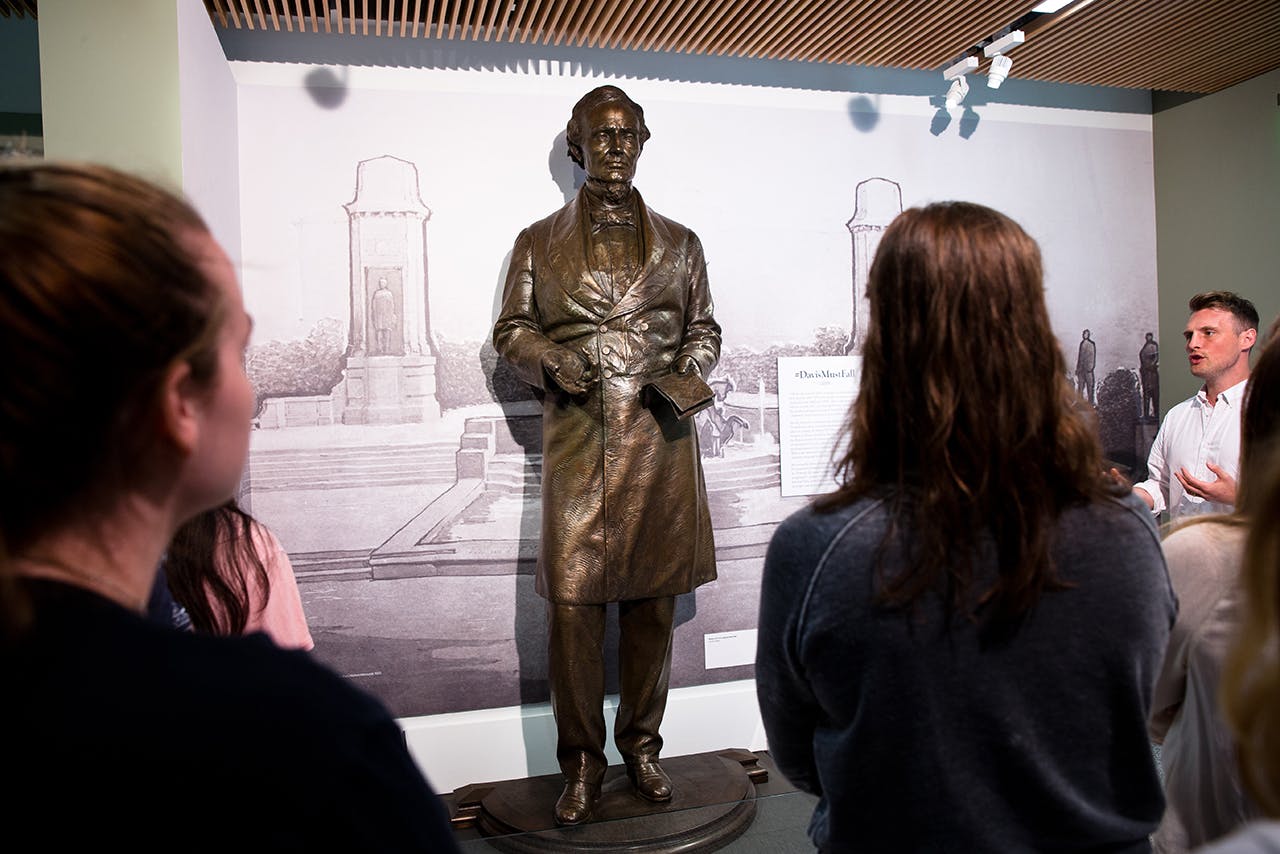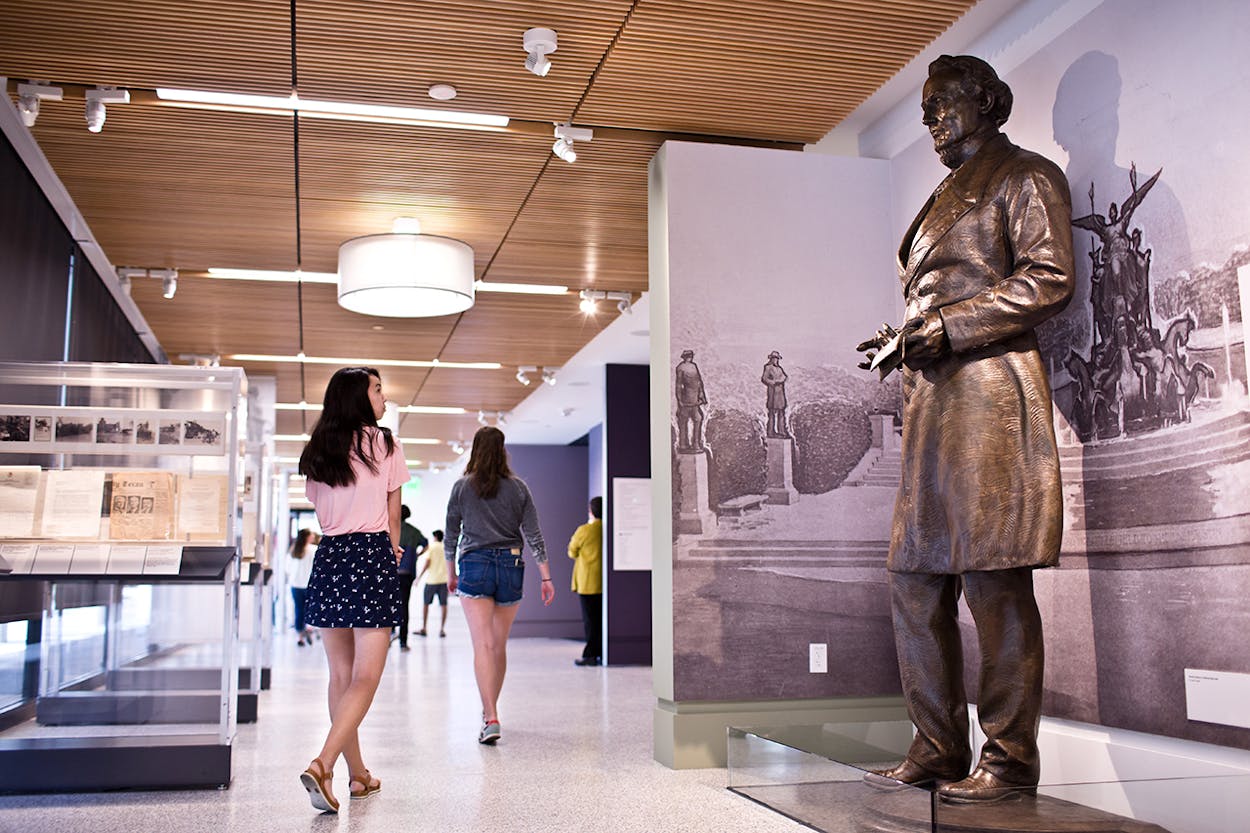Nineteen months after being forklifted off its limestone plinth on the University of Texas at Austin’s Main Mall, placed in the back of pickup, and hauled off, the controversial Jefferson Davis statue is back on campus.
But instead of casting a fixed gaze southward over Austin from its former place of prominence, the 9-foot-tall, 1,200-pound former president of the Confederate States of America now resides at the Briscoe Center for American History, where he looks westward, past some display cases, through a window, and out over the LBJ Presidential Library’s fountain—albeit with a view partially obstructed by low-hanging tree limbs.
The statue was originally commissioned in the 1920s by George Littlefield as part of what was to be a larger Confederate memorial. Littlefield, a rancher, banker, UT regent, and veteran of the Confederate Army’s famed Terry’s Texas Rangers who had fought at Shiloh, Perryville, and Chickamauga, was a fan of Davis, and once referred to him as “the greatest man the South ever produced.” He hired famed Italian sculptor Pompeo Coppini to create the likeness.
In 1924, the statue was cast in, of all places, Brooklyn, New York, and the finished bronze was then shipped to Galveston before making its way by train to Austin. Davis debuted at the American National Bank, located in the same Littlefield Building that still stands at the corner of Sixth Street and Congress Avenue in downtown Austin. In 1925, the statue was moved up the street to the Capitol and stayed there until 1933, when it made its way to the Forty Acres.
Coppini had argued against a larger Confederate memorial. “As time goes by,” he said, people “will look to the Civil War as a blot on the pages of American history, and the Littlefield Memorial will be resented as keeping up the hatred between the Northern and Southern states.” But for its first few decades on the UT campus, the statue stood mostly unnoticed (except by numerous pigeons and grackles). Coppini was right. Over the years, Davis would become the object of occasional controversy and vandalism, and during the 1990s and early 2000s, campus activists, citing Davis’s racist actions, began protesting against the statue with greater intensity. Rallies were held, op-eds appeared in the Daily Texan, and there were more frequent incidences of vandalism. Yet none of these actions effected even a bit of budging.
But in March 2015, a consequential series of events began to unfold on campus and around the world. The first was the election of a pair of editors from UT’s satire magazine, the Texas Travesty, as president and vice president of UT’s Student Government. The unlikely ticket of Xavier Rotnofsky and Rohit Mandalapu had campaigned on such wide-ranging promises as bringing a Chili’s restaurant to campus and the removal of the Jefferson Davis statue. Though Rotnofsky and Mandalapu had originally intended their candidacies as a stunt, once in office they took their duties seriously. The pair drafted a resolution calling for the statue’s removal and the Student Government passed it almost unanimously. The Chili’s resolution, if one was ever written up, did not realize the same success.

Then, on the evening of June 17, 2015, nine black people were massacred at the Emanuel African Methodist Episcopal Church, in Charleston, South Carolina. As the racist motives behind the horrific shooting were revealed and images of the perpetrator posing with Confederate flag were disseminated, the focus on publicly displayed Confederate symbols, including the Davis statue on UT’s campus, sharpened. Calls for their removal, now bull-horned across social media, intensified greatly.
That same month, responding to the student government’s action and the loudening outcry, newly-hired UT president Greg Fenves put together a twelve-member advisory panel consisting of students, professors, and alumni to evaluate the contextual appropriateness of the Jefferson Davis statue, as well as a handful of other statues of notable Confederates. [Full disclosure: the panel included Texas Monthly’s general counsel, Laura Beckworth.]
In July, the Confederate flag that had flown over South Carolina’s statehouse in Columbia for 54 years was permanently removed.
South Carolina taking down the confederate flag – a signal of good will and healing, and a meaningful step towards a better future.
— President Obama (@POTUS44) July 10, 2015
The UT advisory panel made its recommendations in August: either relocate the statues or update them with explanatory plaques. President Fenves, just two months into his presidency, ordered the Davis statue, the most controversial of the lot, to be removed immediately. “I have decided that the best location for the Jefferson Davis statue is UT’s Briscoe Center for American History,” he said in an official statement. “While every historical figure leaves a mixed legacy, I believe Jefferson Davis is in a separate category, and that it is not in the university’s best interest to continue commemorating him on our Main Mall. Davis had few ties to Texas; he played a unique role in the history of the American South that is best explained and understood through an educational exhibit.”
Jefferson Davis statue will be relocated to an educational exhibit at the Dolph Briscoe Center for American History. https://t.co/gjnTm61eHq
— UT Austin (@UTAustin) August 13, 2015
The decision was met with applause from supporters and harrumphs from detractors. The Sons of Confederate Veterans sued UT in an attempt to prevent the removal. The Sons claimed that UT needed approval from the State Preservation Board, the Texas Historical Commission, and the Legislature to relocate the statue. They also argued that, in accordance with George Littlefield’s last wishes, the statues had to stay put. The Sons failed in court.
Davis’s arrival at the Briscoe is part of a major relaunch of the center. In the fall of 2015, the center closed its public spaces for an 18-month renovation that updated and expanded the reading room and added 4,000 square feet of new exhibit space. When the center reopened earlier this month, the general public was able to view its inaugural exhibit, “Exploring the American South,” which pairs well with the Davis statue exhibit, “From Commemoration to Education.” A large label with the heading “#DavisMustFall” affixed to the wall to the right of the statue makes the case for Davis’s reemergence at the center: “By moving the statue of Jefferson Davis to the Briscoe Center, it is preserved as historical evidence and as an original work of art. However, the statue’s presence in an educational exhibit—as opposed to a place of honor on campus—underlines the fact that Davis, as well as many of his ideas and actions, are no longer commemorated or endorsed by the university.” (A point brought home by the fact that Davis’s new environs are rather small and cramped, compared to his former, more spacious accommodations.)
“The statue has been taken out of its place of honor and appropriately refurbished as an educational tool,” says Rotnofsky, who now lives in Los Angeles and occasionally produces commercials for a Texas-based hot sauce company. “Jeff’s removal is a testament to student activism—none of this would have happened without the support of thousands of students. Mission accomplished.”








